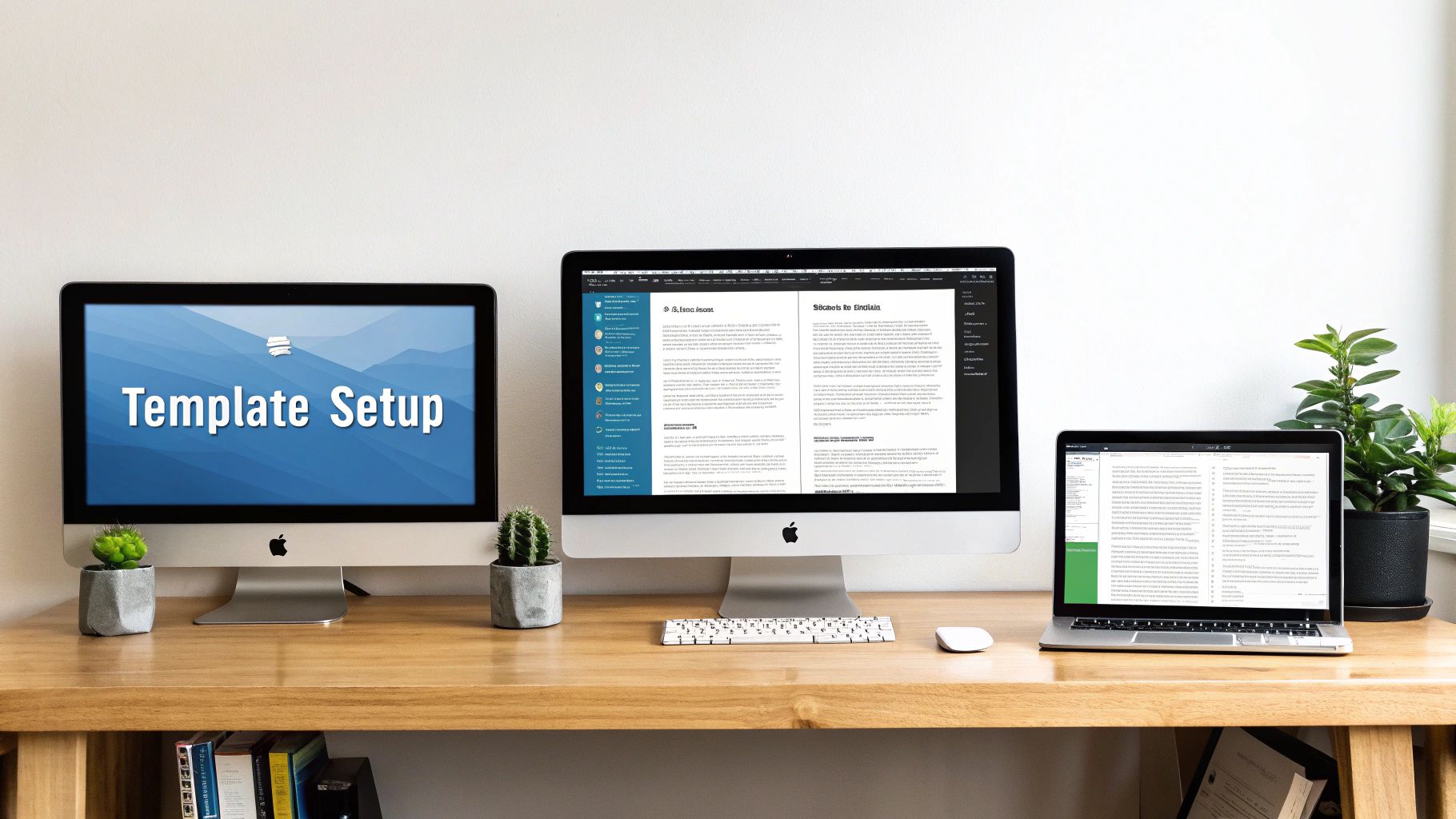GitHub PR Template: Streamline Your Code Reviews
The Power of Structured Pull Requests

Have you ever struggled to understand a pull request? Sifting through lines of code without a clear grasp of the changes can be a real headache, particularly in busy development environments. Thankfully, there's a simple yet effective solution: GitHub PR templates.
These templates are rapidly becoming essential for successful development teams. They bring order to the often chaotic world of code submissions, transforming them into organized and understandable contributions. This leads to quicker review cycles and, ultimately, better code quality.
Think of PR templates as a shared language for your team. They provide a consistent structure for every pull request, minimizing the need for constant clarification. A well-designed template might include sections for describing the changes, explaining the rationale behind them, and even incorporating a quality assurance checklist.
Streamlining the Review Process with Context
This structured approach ensures crucial context is readily available within the pull request itself. This significantly streamlines the review process, making it more efficient for everyone involved. As of 2024, companies like dbt Labs emphasize the value of these templates in their workflows.
A well-structured template typically includes sections for describing the changes, explaining the motivation, and providing a checklist for quality control. This minimizes back-and-forth communication, clarifies expectations, and leads to improved code quality. Axolo also recommends using templates for consistency across different pull request types, whether bug fixes, new features, or documentation updates. For a deeper dive into this topic, check out dbt Labs' blog post on analytics pull request templates. This structured approach fosters focused code reviews and faster turnaround times.
Key Benefits of Using GitHub PR Templates
GitHub PR templates offer numerous advantages for both individual developers and the team as a whole. Here are some of the key benefits:
- Improved Clarity: Templates ensure all the necessary information is readily available, reducing ambiguity and confusion.
- Reduced Review Time: Reviewers can quickly understand the context and changes, accelerating the feedback process.
- Enhanced Consistency: Standardized templates promote a unified workflow, ensuring all pull requests meet the same quality standards.
- Increased Productivity: Less time spent on clarification and rework means greater overall team productivity.
- Better Code Quality: Structured reviews and checklists enable more thorough code analysis, resulting in fewer errors.
By adopting GitHub PR templates, development teams can create a more streamlined, efficient, and productive code review process, leading to higher quality software.
Building Your First GitHub PR Template That Works

Let's get practical and create a GitHub PR template that developers will actually use. This section offers a step-by-step guide to implementing your first template, focusing on effectiveness and ease of use.
Where to Place Your Template Files
For easy access, place your GitHub PR template file (PULL_REQUEST_TEMPLATE.md) in the root directory of your repository, or within a .github folder. This makes it easy for GitHub to automatically suggest the template when a new pull request is created.
For larger projects with various PR types, consider multiple templates within a .github/PULL_REQUEST_TEMPLATE directory. This allows contributors to choose the most suitable template, enhancing workflow efficiency.
Structuring Your Template for Clarity
A well-structured template is key to a smooth review process. Clear headings (using #) are essential for separating different sections. This improves readability and organization.
Consider including sections for:
- Description: A brief overview of the changes implemented.
- Motivation: The reasoning behind the code modifications.
- Testing: Instructions for reviewers to test the changes.
- Checklist: Essential verification steps, like passing tests and documenting code.
For additional insights on effective pull requests, check out the Pull Request Best Practices.
Formatting For Easy Scanning
Use Markdown formatting to enhance readability. Bullet points for lists, code blocks for code snippets, and bold text for highlighting key information make the template easy to scan and understand quickly. For more tips on using checklists effectively within your templates, see this guide on How to master GitHub PR template checklists.
Balancing Guidance and Brevity
A concise, yet informative template is the goal. While guidance is important, a lengthy template can be discouraging. Aim for a balance that encourages consistent use and a positive developer experience.
A well-designed template reduces friction in the development process, leading to a more productive and efficient team. Here's a table summarizing key sections for different PR types:
This table outlines recommended sections for various pull request types and their importance:
| Template Section | Feature PR | Bug Fix PR | Documentation PR | Importance Level | |---|---|---|---|---| | Description | Required | Required | Required | High | | Motivation | Required | Required | Optional | Medium | | Testing | Required | Required | Optional | High | | Checklist | Required | Required | Optional | High | | Screenshots/Videos | Optional | Recommended | Optional | Medium |
This table helps clarify which sections are crucial for different PR types. A concise description and thorough testing instructions are vital across the board. Motivation is important for understanding the context of changes, particularly in feature and bug fix PRs. Checklists help ensure completeness and consistency.
Practical Tips for Creating Effective Templates
Remember, the goal is to create a template that streamlines the review process and improves code quality. A few key considerations:
- Target Audience: Consider the needs and experience levels of your team when designing your template.
- Consistency: Maintain a consistent structure and format across all your templates.
- Regular Review: Periodically review and update your templates to ensure they remain relevant and effective.
Tailoring Templates to Different Contribution Types

A one-size-fits-all GitHub PR template rarely works. Different contributions, like adding features, fixing bugs, refactoring, and updating documentation, each have unique needs. This means tailoring your templates is crucial for efficient code reviews. Let's explore how to create specialized templates for each contribution type.
Feature Additions
When adding a new feature, the GitHub PR template should focus on the "why" and "how." It should prompt contributors to clearly describe the feature's purpose and functionality.
It should also explain the design decisions made and the implementation chosen. Providing testing instructions allows reviewers to easily validate the new feature. Finally, including screenshots or videos demonstrating the functionality helps reviewers visualize the changes.
Bug Fixes
For bug fix pull requests, clarity and reproducibility are key. The template should guide contributors to thoroughly describe the bug, including clear steps to reproduce the issue.
The proposed solution should be explained, highlighting how it addresses the root cause of the bug. Including before-and-after comparisons can be invaluable for reviewers to quickly grasp the impact of the fix.
Refactoring
Refactoring often involves significant code alterations without introducing new features. Your GitHub PR template should therefore emphasize the "why" and "what" of the changes.
Contributors should explain the motivation behind the refactoring and describe the scope of changes and affected code areas. Including performance benchmarks or code complexity metrics can showcase improvements achieved.
Documentation Updates
Documentation PRs require a different approach than code changes. The GitHub PR template should guide contributors to summarize the updated documentation sections and explain the rationale behind the changes.
Providing direct links to the updated documentation or relevant resources makes it easy for reviewers to assess the changes.
Furthermore, GitHub pull request templates help streamline external contributions and ensure they align with organizational standards. By including sections for issue ticket numbers and related discussions, contributors can connect their pull requests to existing projects and conversations. This fosters smoother interactions with external contributors and enhances project transparency and accountability. GitHub offers robust issue and pull request template functionalities, allowing teams to customize templates based on specific project needs. Learn more about this at Axolo.
Conditional Sections and Optional Fields
Introducing conditional sections and optional fields within your GitHub PR templates offers flexibility without sacrificing essential information. These adaptable templates empower contributors to provide relevant information specific to each contribution type. This approach also helps reduce template fatigue, ensuring consistent use and maintaining high-quality pull requests. By tailoring your templates, you streamline the review process and improve the quality of contributions.
Template Strategies From Elite Engineering Teams

What distinguishes truly effective engineering teams from the rest when it comes to their GitHub PR templates? It's their ability to strike a balance: providing comprehensive information while also ensuring a smooth, efficient review process. Let's explore how these teams achieve this.
Balancing Information and Reviewer Experience
Top-performing teams understand that a GitHub PR template needs to be informative, but not overwhelming. They prioritize clarity and conciseness, making sure reviewers can quickly understand the context and the changes being proposed.
This is often accomplished through strategic formatting within the template itself. Clear headings separate different sections, bullet points highlight key changes, and bold text emphasizes critical details. This allows reviewers to efficiently navigate the PR and focus their attention effectively. For a deeper dive into creating effective GitHub PR templates, check out this comprehensive guide: Read also: GitHub Pull Request Template: The Complete Guide to Code Reviews.
Elements of High-Impact Templates
High-impact templates consistently incorporate certain key elements. These usually include a clear description of the proposed changes, the reasoning behind them, clear testing instructions, and a structured checklist for reviewers.
By including these components, teams ensure that all the necessary information is readily accessible, minimizing back-and-forth communication and accelerating the review process. This ultimately contributes to faster development cycles and higher code quality. Furthermore, pull request analytics tools can provide valuable data on template effectiveness. For example, GitHub Actions like pull-request-analytics-action can track metrics like time-to-review and approval rates, allowing teams to optimize their workflows. This data-driven approach leads to improved project management and better collaboration. Find more detailed statistics here.
Fostering Team Buy-In and Adaptability
Creating a great GitHub PR template is only the first step. Successful implementation requires team buy-in. Elite teams achieve this by involving developers in the template design process from the beginning.
This collaborative approach ensures the template meets the team's specific needs and promotes a sense of ownership. Equally important is the understanding that templates should not be static. High-performing teams regularly review and update their templates, incorporating feedback from developers and adapting to evolving project requirements. This iterative process keeps the template relevant and effective, preventing template fatigue and encouraging consistent usage throughout the project lifecycle.
Measuring Real Impact of Your PR Templates
Beyond gut feelings, how do you truly know if your GitHub PR templates are working? The real test lies in measuring their actual impact. This means tracking the right metrics and gathering feedback to constantly refine your approach.
Key Metrics for Template Success
Several key metrics offer valuable insights into template effectiveness. These include review cycle duration, or the time it takes to review and merge a pull request. We also look at first-time approval rates: the percentage of pull requests approved without needing revisions. Finally, the number of comments per pull request tells us how clear and complete the initial submission was. Monitoring these metrics highlights where templates excel and where they need improvement. This data-driven approach helps fine-tune your templates for maximum impact.
For instance, a significant drop in review cycle duration suggests your templates are streamlining the review process. On the other hand, a high number of comments per pull request could mean the templates aren't clear enough, leading to more back-and-forth between reviewers and contributors.
To better understand the performance of your PR templates, consider tracking these metrics:
PR Template Performance Metrics: Key metrics to track when evaluating the effectiveness of your PR templates
| Metric | Description | Target Improvement | Measurement Method | | -------------------------- | ------------------------------------------------------------------------------ | ----------------- | ----------------------- | | Review Cycle Duration | Time taken to review and merge a pull request | Decrease | Graphite or similar tool | | First-Time Approval Rate | Percentage of pull requests approved without revisions | Increase | Internal Tracking | | Comments per Pull Request | Number of comments on a pull request, reflecting clarity and completeness | Decrease | Internal Tracking |
By analyzing these metrics, you can tailor your templates to optimize your workflow. Focusing on these key areas will contribute to a more efficient and effective PR process.
Establishing Meaningful Benchmarks
High-performing teams know the importance of setting benchmarks aligned with their workflow priorities. These benchmarks provide a reference point for evaluating the effectiveness of their GitHub PR templates. These can vary depending on whether the team prioritizes speed, quality, or a balance of both.
For example, a team focused on speed might aim to reduce review cycle duration by a specific percentage. A team prioritizing quality might target a higher first-time approval rate. These tailored benchmarks allow teams to focus on the metrics that matter most, ensuring their GitHub PR templates directly contribute to their goals.
Integrating GitHub pull request templates with analytics tools can provide valuable data on developer productivity and code quality. Tools like Graphite offer analytics that track metrics like PR merge time, review cycles, and wait times, helping teams assess the impact of their templates. Analyzing these metrics helps teams adjust their templates for better review efficiency and code maintainability.
Gathering Feedback and Iterating
Gathering both quantitative and qualitative feedback is essential for continuous improvement. While metrics provide valuable data, developer feedback offers insights into the templates' practical usability.
Use surveys, informal check-ins, or dedicated feedback sessions to understand developers' experiences. Are the templates helpful? Are they too complex or too simple? This direct feedback helps pinpoint pain points and uncover areas for improvement. Resources like this guide on measuring code quality can be invaluable. By combining quantitative data with qualitative insights, you can iteratively refine your GitHub PR templates, ensuring they remain effective and valuable tools. This continuous improvement creates templates that meet current needs and adapt to evolving requirements as projects grow. The goal is to empower developers with templates that streamline workflows, enhance collaboration, and ultimately contribute to better software.
Taking Your GitHub PR Templates to the Next Level
For teams wanting to get the most out of their GitHub PR templates, simply having one isn't enough. This section explores advanced strategies that transform your templates from basic checklists into powerful automation tools, seamlessly integrated into a robust development workflow.
Dynamic Templates With GitHub Actions
Imagine a GitHub PR template that intelligently adapts to the contribution type. This is achievable using GitHub Actions. You can configure actions to dynamically fill template sections based on factors like branch names, modified files, or even the contribution type (feature, bug fix, etc.).
For example, a PR from a feature branch could automatically include feature-specific sections like "User Story" or "Acceptance Criteria." A hotfix branch could trigger a template emphasizing urgency and rollback procedures. This dynamic approach removes manual adjustments, ensuring the right information is always present.
Integrating With CI/CD Pipelines
Seamless integration between your GitHub PR templates and your CI/CD pipelines unlocks powerful automation. You can set up actions to trigger automated builds, tests, and even deployments directly from template information.
This allows for rapid feedback on changes, catching errors early. For instance, a "Code Coverage Report Generated" checkbox in the template could trigger an action to automatically generate and attach the report to the PR. This eliminates manual steps and enforces quality standards.
Reinforcing Architecture and Security
GitHub PR templates can also safeguard your project's architecture and security. Including specific checks and guidelines within the template reinforces architectural boundaries and ensures adherence to security best practices.
A template might include a "Security Review Completed" section, requiring contributors to confirm they've considered security implications. Or, an "Architectural Compliance" checklist could prompt developers to verify adherence to established guidelines.
Maintaining Institutional Knowledge
Templates act as a valuable store of institutional knowledge. By embedding best practices, coding standards, and common issues within the template, you can onboard new team members effectively and preserve crucial information.
This living documentation reduces reliance on informal knowledge sharing and ensures consistent coding style and practices. Consider it a constantly evolving guide, making your team's collective wisdom accessible to everyone.
Balancing Automation and Human Judgment
While automation is powerful, it's essential to balance it with human judgment. GitHub PR templates should guide and assist, not dictate.
Encourage developers to think critically and provide opportunities for open discussion and collaboration within the PR process. Templates should enhance, not replace, human interaction in software development.
Evolving Your Templates
Like your codebase, your GitHub PR templates should evolve. Regularly review and update them based on feedback, evolving best practices, and changing project needs.
This ensures your templates stay relevant and valuable, contributing to a smooth, efficient, and high-quality development process. Continuous improvement allows your templates to support your team's growth and project success.
Ready to improve your code review process and boost productivity? Check out Pull Checklist, a GitHub Marketplace app that automates and enhances code reviews with powerful, conditional checklists. Improve code quality, reduce errors, and ensure consistency across your codebase.
